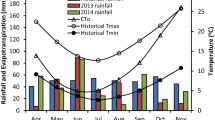Abstract
CERES-Wheat, a dynamic process crop growth model, is specified and validated for eight sites in the major wheat-growing regions of China. Crop model results are then used to test the Mitscherlich-Baule and the quadratic functional forms for yield response to nitrogen fertilizer, irrigation water, temperature, and precipitation. The resulting functions are designed to be used in a linked biophysical-economic model of land-use and land-cover change in China. While both functions predict yield responses adequately, the Mitscherlich-Baule function is preferable to the quadratic function because its parameters are biologically and physically realistic. Variables explaining a significant proportion of simulated yield variance are nitrogen, irrigation water, and precipitation; temperature was a less significant component of yield variation within the range of observed year-to-year variability at the study sites. Crop model simulations with a generic soil with median characteristics of the eight sites compared to simulations with site-specific soils showed that agricultural soils in China have similar and, in general, low-to-moderate water-holding capacities and organic matter contents. The validated crop model is useful for simulating the range of conditions under which wheat is grown in China, and provides the means to estimate production functions when experimental field data are not available.
Similar content being viewed by others
References
C. Ackello-Ogutu, Q. Paris and W.A. Williams, Testing a von Liebig crop response function against polynomial specifications, American Journal of Agricultural Economics 67 (1985) 873–880.
W. Baier, Crop-weather analysis model: Review and model development, Journal of Applied Meterorology 12 (1973) 937–947.
FAS, Foreign Agricultural Service of the U.S. Department of Agriculture (1997).
G. Fischer, Y. Ermoliev, M.A. Keyzer and C. Rosenzweig, Simulating the socio-economic and biogeophysical driving forces of land-use and land-cover change: The IIASA land-use change model, IIASA Working Paper WP–96–010 (1996).
G. Fischer and G.K. Heilig, Population momentum and the demand on land and water resources, Philos. Trans. Roy. Soc. London B 352 (1997) 869–889.
Food and Agriculture Organization of the United Nations (1999); http://apps.fao.org.
M.D. Frank, B.R. Beattie and M.F. Embleton, A comparison of alternative crop response models, American Journal of Agricultural Economics 72 (1990) 597–602.
D.C. Godwin and C.A. Jones, Nitrogen dynamics in soil-plant systems, in: Modeling Plant and Soil Systems, Agronomy Series No. 31, eds. J. Hanks and J.T. Ritchie (American Society of Agronomy, Madison, WI, 1991) pp. 287–321.
D. Godwin, J. Ritchie, U. Singh and L. Hunt, A Users Guide to CERES Wheat, Version 2.10 (International Fertilizer Development Center, Muscle Shoals, AL, 1990) p. 94.
S.S. Grimm, Q. Paris and W.A. Williams, A von Liebig model for water and nitrogen crop response, Western Journal of Agricultural Economics 12 (1987) 182–192.
IIASA, Iiasa.ac.at/Research/LUC/GIS/giswebpage (18 May 1998).
Z. Jin, D. Ge, H. Chen and J. Fang, Effects of climate change on rice production and strategies for adaptation in southern China, in: Climate Change and Agriculture: Analysis of Potential International Impacts, Special Publication No. 59, eds. C. Rosenzweig, L.H. Allen, Jr., L.A. Harper, S.E. Hollinger and J.W. Jones (American Society of Agronomy, Madison, WI, 1995) pp. 307–323.
M.A. Keyzer, Formulation and spatial aggregation of agricultural production relationships within the Land Use Change (LUC) model, IR–98–092, International Institute for Applied Systems Analysis, Laxenburg (1998).
G.J. Kovacs, T. Nemeth and J.T. Ritchie, Testing simulation models for the assessment of crop production and nitrate leaching in Hungary, Agricultural Systems 49 (1995) 385–397.
R.V. Llewelyn and A.M. Featherstone, A comparison of crop production functions using simulated data for irrigated corn in western Kansas, Agricultural Systems (1997).
J. Ramirez, C.M. Sakamoto and R.E. Jensen, Wheat, in: Impacts of Climate Change on the Biosphere, CIAP Monograph No. 5, Part 2. Climatic Effects (1975) pp. 4–37–4–90.
C.W. Richardson and D.A. Wright, WGEN: A Model for Generating Daily Weather Variables, ARS-8 (U.S. Department of Agriculture, Agricultural Research Service, Washington, DC, 1984) p. 83.
J.T. Ritchie, A user-orientated model of the soil water balance in wheat, in: Wheat Growth and Modelling, eds. W. Day and R.K. Atkin (Plenum, New York, 1985) pp. 293–306.
J.T. Ritchie, D.C. Godwin and S. Otter-Nacke, CERES-Wheat. A Simulation Model of Wheat Growth and Development (Texas A&M University Press, College Station, TX, 1988).
J.T. Ritchie and S. Otter, Description and performance of CERES-Wheat: A user-oriented wheat yield model, in: ARS Wheat Yield Project, ARS-38, ed. W.O. Willis (U.S. Department of Agriculture, Agricultural Research Service, Washington, DC, 1985) pp. 159–175.
C. Rosenzweig and D. Hillel, Climate Change and the Global Harvest: Potential Impacts of the Greenhouse Effect on Agriculture (Oxford University Press, New York, 1998) p. 336.
C. Rosenzweig and A. Iglesias, The use of crop models for international climate change impact assessment, in: Understanding Options for Agricultural Production, eds. G.Y. Tsuji, G. Hoogenboom and P.K. Thornton (Kluwer, Dordrecht, 1998) pp. 267–292.
S.M. Scheierling, G.E. Cardon and R.A. Young, Impact of irrigation timing on simulated water-crop production functions, Irrigation Science 18 (1997) 23–31.
M.A. Semenov, J. Wolf, L.G. Evans, H. Ackersten and A. Iglesias, Comparison of wheat simulation models under climate change, Climate Research 7 (1996) 271–181.
L.M. Thompson, Weather and technology in the production of wheat in the United States, Journal of Soil and Water Conservation 24 (1969) 219–224.
P.E. Waggoner, Agriculture and a climate changed by more carbon dioxide, in: Changing Climate (National Academy of Sciences Press, Washington, DC, 1983) pp. 383–418.
J.R. Williams, P.T. Dyke and C.A. Jones, EPIC — A model for assessing the effects of erosion on soil productivity, in: Proc. 3rd Int. Conf. on State-of-the-Art in Ecological Modelling, eds. W.K. Lavenroth et al., Fort Collins, CO, 24–28 May 1982 (Elsevier, New York, 1983).
Author information
Authors and Affiliations
Rights and permissions
About this article
Cite this article
Rosenzweig, C., Iglesias, A., Fischer, G. et al. Wheat yield functions for analysis of land-use change in China. Environmental Modeling & Assessment 4, 115–132 (1999). https://doi.org/10.1023/A:1019008116251
Issue Date:
DOI: https://doi.org/10.1023/A:1019008116251




